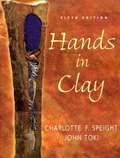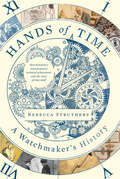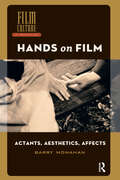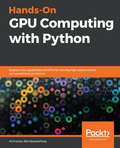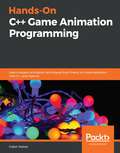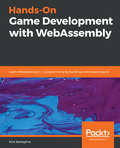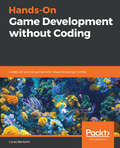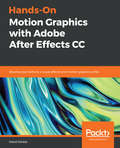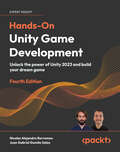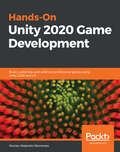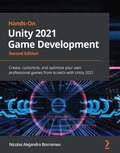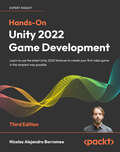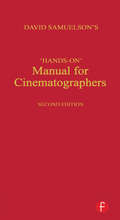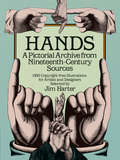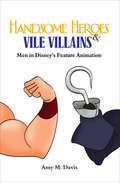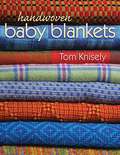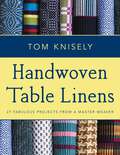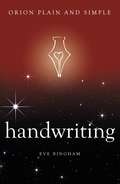- Table View
- List View
Hands In Clay
by Charlotte Speight John TokiThis is the only full four-color introductory ceramics text available that combines a thorough appreciation of the aesthetics of ceramic art with extensive discussions of the history of ceramics as well as techniques for working in clay.
Hands of Time: A Watchmaker's History
by Rebecca Struthers"Forty-thousand years of our relationship with time condensed into 288 pages: a hugely entertaining achievement." –Esquire"As impeccably crafted and precisely engineered as any of the watches on which the author has worked so lovingly over the years, this book is a joy to behold and a wonder to enjoy.” –Simon Winchester, author of The Perfectionists and LandAn award-winning watchmaker—one of the few practicing the art in the world today—chronicles the invention of time through the centuries-long story of one of mankind’s most profound technological achievements: the watch.Timepieces have long accompanied us on our travels, from the depths of the oceans to the summit of Everest, the ice of the arctic to the sands of the deserts, outer space to the surface of the moon. The watch has sculpted the social and economic development of modern society; it is an object that, when disassembled, can give us new insights both into the motivations of inventors and craftsmen of the past, and, into the lives of the people who treasured them.Hands of Time is a journey through watchmaking history, from the earliest attempts at time-keeping, to the breakthrough in engineering that gave us the first watch, to today – where the timepieces hold cultural and historical significance beyond what its first creators could have imagined. Acclaimed watchmaker Rebecca Struthers uses the most important watches throughout history to explore their attendant paradigm shifts in how we think about time, indeed how we think about our own humanity. From an up-close look at the birth of the fakes and forgeries industry which marked the watch as a valuable commodity, to the watches that helped us navigate trade expeditions, she reveals how these instruments have shaped how we build and then consequently make our way through the world.A fusion of art and science, history and social commentary, this fascinating work, told in Struthers’s lively voice and illustrated with custom line drawings by her husband and fellow watchmaker Craig, is filled with her personal observations as an expert watchmaker—one of the few remaining at work in the world today. Horology is a vast subject—the “study of time.” This compelling history offers a fresh take, exploring not only these watches within their time, but the role they played in human development and the impact they had on the people who treasured them.
Hands on Film: Actants, Aesthetics, Affects (Film Culture in Transition)
by Barry MonahanHands on Film is a comprehensive study of the representations and on-screen uses of the human limb, spanning the history of the cinema from its birth to contemporary times. It examines how filmmakers have framed the hand for a variety of effects, from stylistic to thematic, and for the development of characterisation and narrative. The book offers insights into how films have created meaning by focusing on that part of the anatomy and, in turn, proposes a variety of ways in which its on-screen appearances might shed light on what it means to be sentient, cultured, and creative beings in the world.
Hands-On GPU Computing with Python: Explore the capabilities of GPUs for solving high performance computational problems
by Avimanyu BandyopadhyayExplore GPU-enabled programmable environment for machine learning, scientific applications, and gaming using PuCUDA, PyOpenGL, and Anaconda AccelerateKey FeaturesUnderstand effective synchronization strategies for faster processing using GPUsWrite parallel processing scripts with PyCuda and PyOpenCLLearn to use the CUDA libraries like CuDNN for deep learning on GPUsBook DescriptionGPUs are proving to be excellent general purpose-parallel computing solutions for high performance tasks such as deep learning and scientific computing.This book will be your guide to getting started with GPU computing. It will start with introducing GPU computing and explain the architecture and programming models for GPUs. You will learn, by example, how to perform GPU programming with Python, and you’ll look at using integrations such as PyCUDA, PyOpenCL, CuPy and Numba with Anaconda for various tasks such as machine learning and data mining. Going further, you will get to grips with GPU work flows, management, and deployment using modern containerization solutions. Toward the end of the book, you will get familiar with the principles of distributed computing for training machine learning models and enhancing efficiency and performance.By the end of this book, you will be able to set up a GPU ecosystem for running complex applications and data models that demand great processing capabilities, and be able to efficiently manage memory to compute your application effectively and quickly.What you will learnUtilize Python libraries and frameworks for GPU accelerationSet up a GPU-enabled programmable machine learning environment on your system with AnacondaDeploy your machine learning system on cloud containers with illustrated examplesExplore PyCUDA and PyOpenCL and compare them with platforms such as CUDA, OpenCL and ROCm.Perform data mining tasks with machine learning models on GPUsExtend your knowledge of GPU computing in scientific applicationsWho this book is forData Scientist, Machine Learning enthusiasts and professionals who wants to get started with GPU computation and perform the complex tasks with low-latency. Intermediate knowledge of Python programming is assumed.
Hands-On GPU-Accelerated Computer Vision with OpenCV and CUDA: Effective techniques for processing complex image data in real time using GPUs
by Bhaumik VaidyaDiscover how CUDA allows OpenCV to handle complex and rapidly growing image data processing in computer and machine vision by accessing the power of GPUKey FeaturesExplore examples to leverage the GPU processing power with OpenCV and CUDAEnhance the performance of algorithms on embedded hardware platformsDiscover C++ and Python libraries for GPU accelerationBook DescriptionComputer vision has been revolutionizing a wide range of industries, and OpenCV is the most widely chosen tool for computer vision with its ability to work in multiple programming languages. Nowadays, in computer vision, there is a need to process large images in real time, which is difficult to handle for OpenCV on its own. This is where CUDA comes into the picture, allowing OpenCV to leverage powerful NVDIA GPUs. This book provides a detailed overview of integrating OpenCV with CUDA for practical applications. To start with, you’ll understand GPU programming with CUDA, an essential aspect for computer vision developers who have never worked with GPUs. You’ll then move on to exploring OpenCV acceleration with GPUs and CUDA by walking through some practical examples.Once you have got to grips with the core concepts, you’ll familiarize yourself with deploying OpenCV applications on NVIDIA Jetson TX1, which is popular for computer vision and deep learning applications. The last chapters of the book explain PyCUDA, a Python library that leverages the power of CUDA and GPUs for accelerations and can be used by computer vision developers who use OpenCV with Python.By the end of this book, you’ll have enhanced computer vision applications with the help of this book's hands-on approach.What you will learnUnderstand how to access GPU device properties and capabilities from CUDA programsLearn how to accelerate searching and sorting algorithmsDetect shapes such as lines and circles in imagesExplore object tracking and detection with algorithmsProcess videos using different video analysis techniques in Jetson TX1Access GPU device properties from the PyCUDA programUnderstand how kernel execution worksWho this book is forThis book is a go-to guide for you if you are a developer working with OpenCV and want to learn how to process more complex image data by exploiting GPU processing. A thorough understanding of computer vision concepts and programming languages such as C++ or Python is expected.
Hands-On GUI Application Development in Go: Build Responsive, Cross-platform, Graphical Applications With The Go Programming Language
by Andrew WilliamsGo Developers who want to build beautiful GUI applications in Go
Hands-On Game Animation Programming: Learn Modern Animation Techniques From Theory To Implementation With C++ And Opengl
by Gabor SzauerThis book is for professional, independent, and hobbyist developers interested in building a robust animation system from the ground up. Some knowledge of the C++ programming language will be helpful.
Hands-On Game Development with WebAssembly: Learn WebAssembly C++ programming by building a retro space game
by Rick BattaglineMake your WebAssembly journey fun while making a game with itKey FeaturesCreate a WebAssembly game that implements sprites, animations, physics, particle systems, and other game development fundamentalsGet to grips with advanced game mechanics in WebAssemblyLearn to use WebAssembly and WebGL to render to the HTML5 canvas elementBook DescriptionWithin the next few years, WebAssembly will change the web as we know it. It promises a world where you can write an application for the web in any language, and compile it for native platforms as well as the web.This book is designed to introduce web developers and game developers to the world of WebAssembly by walking through the development of a retro arcade game. You will learn how to build a WebAssembly application using C++, Emscripten, JavaScript, WebGL, SDL, and HTML5.This book covers a lot of ground in both game development and web application development. When creating a game or application that targets WebAssembly, developers need to learn a plethora of skills and tools. This book is a sample platter of those tools and skills. It covers topics including Emscripten, C/C++, WebGL, OpenGL, JavaScript, HTML5, and CSS. The reader will also learn basic techniques for game development, including 2D sprite animation, particle systems, 2D camera design, sound effects, 2D game physics, user interface design, shaders, debugging, and optimization. By the end of the book, you will be able to create simple web games and web applications targeting WebAssembly.What you will learnBuild web applications with near-native performance using WebAssemblyBecome familiar with how web applications can be used to create games using HTML5 Canvas, WebGL, and SDLBecome well versed with game development concepts such as sprites, animation, particle systems, AI, physics, camera design, sound effects, and shadersDeploy C/C++ applications to the browser using WebAssembly and EmscriptenUnderstand how Emscripten HTML shell templates, JavaScript glue code, and a WebAssembly module interactDebug and performance tune your WebAssembly applicationWho this book is forWeb developers and game developers interested in creating applications for the web using WebAssembly.Game developers interested in deploying their games to the webWeb developers interested in creating applications that are potentially orders of magnitude faster than their existing JavaScript web appsC/C++ developers interested in using their existing skills to deploy applications to the web
Hands-On Game Development without Coding: Create 2D and 3D games with Visual Scripting in Unity
by Lucas BertoliniDevelop your own games with Unity 2D/3D Game Kit and use it for your presentations, kids education, level design, game design, proofs of concept, or even just for fun!Key FeaturesBuild your first ever video game using Unity 2D/3D Game kitLearn how to create game levels, adding props, giving behaviours to objects and working on gameplayStep by step instructions on creating your own AI enemy and interacting with itBook DescriptionHands-On Game Development without Coding is the first Visual Scripting book in the market. It was tailor made for a non programing audience who are wondering how a videogame is made.After reading this book you will be able to develop your own 2d and 3d videogames and use it on your presentations, to speed up your level design deliveries, test your game design ideas, work on your proofs of concept, or even doing it just for fun.The best thing about Hands-On Game Development without Coding is that you don’t need any previous knowledge to read and understand the process of creating a videogame. It is our main focus to provide you with the opportunity to create a videogame as easy and fast as possible.Once you go through the book, you will be able to create player input interaction, levels, object behaviours, enemy AI, creating your own UI and finally giving life to your game by building it.It’s Alive!What you will learnUnderstanding the Interface and kit flow. Comprehend the virtual space and its rules.Learning the behaviours and roles each component must have in order to make a videogame.Learn about videogame developmentCreating a videogame without the need of learning any programming languageCreate your own gameplay HUD to display player and Enemy informationWho this book is forThis book is for anyone who is interested in becoming a game developer but do not posses any coding experience or programming skills. All you need is a computer and basic software interface knowledge.
Hands-On Motion Graphics with Adobe After Effects CC: Develop your skills as a visual effects and motion graphics artist
by David DoddsDiscover techniques to enhance your videos with complex animationKey FeaturesDesign, animate, and sequence a complete motion graphics projectWork with compositions and pre-compositions to create animations speedilyMaximize your motion graphics and visual effects skillsBook DescriptionIf you’re thinking seriously about making and publishing your videos with professional editing and animation, look no further! Adobe After Effects is a popular tool among video editors and YouTubers to enhance their videos and bring them to life by implementing visual effects and motion graphics.This book will take you right from the basics through to the advanced techniques in Adobe After Effects CC 2018. You will start by setting up your editing environment to learn and improve techniques to sharpen your video editing skills. Furthermore, you will work with basic and advanced special effects to create, modify, and optimize motion graphics in your videos. Lastly, you will not only learn how to create 2.5D animations, but also get to grips with using Cinema 4D Lite to build and animate complete 3D scenes.By the end of the book, you’ll have learned how to package a video efficiently with the help of the projects covered.What you will learnCreate a lower third project for a TV show with complex layersWork with shape layer animation to create an animated lyrics videoExplore different tools to animate charactersApply text animation to create a dynamic film-opening titleUse professional visual effects to create a VFX projectModel, light, and composite your 3D project in After EffectsWho this book is forIf you’re a student, professional, YouTuber, or anyone who is interested in video editing, animation, and motion graphics, this book is for you. You’ll also find this resource useful if you’re an Illustrator looking to put your creations in motion.
Hands-On Unity Game Development: Unlock the power of Unity 2023 and build your dream game
by Nicolas Alejandro Borromeo Juan Gabriel SalasUnlock game development mastery with Unity 2023! This book takes you from conception to publication, equipping you with the key tools and techniques you need to bring your gaming vision to life.Key FeaturesLearn the fundamentals of Unity 2023 and create your dream gameExplore the world of augmented reality (AR) to create captivating mobile gamesPropel game performance and player experience to new heights with Data-Oriented Technology Stack (DOTS) insightsBook DescriptionTake your game development skills to the next level. Dive into the world of game creation confidently by elevating your game development skills. This book is your definitive and practical guide to unlocking the full potential of Unity 2023. Every chapter is designed to empower you to customize your own game, not just replicate what's in the book. This new edition includes immersive Augmented Reality (AR) experiences and performance optimization with Data-Oriented Technology Stack (DOTS). From Scene Creation to seamless Assert Integration, dive into C# programming and Visual Scripting with step-by-step guidance for beginners. Implement dynamic gameplay elements, including movement, spawning, physics, and health systems. Delve deeper into the magic of Game AI through sensor-driven decision-making with Finite State Machines (FSMs). Elevate your visuals with materials, shaders, textures, and particle systems. Optimize performance with Profiler insights and debug your game for a polished final product. Whether you're a beginner or a seasoned pro, this book will equip you with the skills needed to bring your game ideas to life.What you will learnBuild a game that includes gameplay, player and non-player characters, assets, animations, and moreLearn C# and Visual Scripting to customize player movements, the UI, and game physicsImplement Game AI to build a fully functional enemy capable of detecting and attackingUse Universal Render Pipeline (URP) to create high-quality visuals with UnityCreate win-lose conditions using design patterns such as Singleton and Event ListenersImplement realistic and dynamic physics simulations with the new Physics SystemWho this book is forBoth game and non-game developers looking to migrate or start building 3D games in Unity will find this Unity game development book useful. While you can still follow along without prior programming experience, knowing C# fundamentals will help you make the most of this book.
Hands-On Unity 2020 Game Development: Build, customize, and optimize professional games using Unity 2020 and C#
by Nicolas Alejandro BorromeoBuild immersive game experiences using the new Unity 2020 features with this practical guide Key Features Unleash the capabilities of C# scripting for creating immersive UI, graphics, Game AI agents and much more Explore Unity's latest tools, including Universal Render Pipeline, Shader Graph, and VFX graph, to enhance graphics and animation Get started with building augmented reality experience using Unity's AR Foundation Book Description Over the years, the Unity game engine has extended its scope from just being about creating video games to building AR/VR experiences, complex simulations, real-time realistic rendering, films, and serious games for training and education. Its features for implementing gameplay, graphics, and customization using C# programming make Unity a comprehensive platform for developing professional-level, rich experiences. With this book, you'll be able to build impressive Unity projects in a step-by-step manner and apply your knowledge of Unity concepts to create a real-world game. Complete with hands-on tutorials and projects, this easy-to-follow guide will show you how to develop your first complete game using a variety of Unity tools. As you make progress, you'll learn how to make the most of the Unity Editor and create scripts using the C# programming language. This Unity game development book will then take you through integrating graphics, sound, and animations and manipulating physics to create impressive mechanics for your games. You'll also learn how to code a simple AI agent to challenge the user and use profiling tools to ensure that the code runs in a performant way. Finally, you'll get to grips with Unity's AR Foundation for creating AR experiences for 3D apps and games. By the end of this book, you'll have developed a complete game and will have built a solid foundation using Unity's tooling ecosystem to develop game projects of any scale. What you will learn Write scripts for customizing various aspects of a game, such as physics, gameplay, and UI Program rich shaders and effects using Unity's new Shader Graph and Universal Render Pipeline Implement postprocessing to increase graphics quality with full-screen effects Create rich particle systems for your Unity games from scratch using VFX Graph and Shuriken Add animations to your game using the Animator, Cinemachine, and Timeline Implement game artificial intelligence (AI) to control character behavior Detect and fix optimization issues using profilers and batching Who this book is for This book is for game developers looking to migrate to the Unity game engine. If you are a developer with some exposure to Unity, this book will help you explore its latest features. Prior experience with C# programming is required to get the most out of the book.
Hands-On Unity 2021 Game Development: Create, customize, and optimize your own professional games from scratch with Unity 2021, 2nd Edition
by Nicolas Alejandro BorromeoAchieve mesmerizing game experiences using the latest Unity 2021 features by following a practical approach to building professional gamesKey FeaturesUnleash the capabilities of C# scripting to create UIs, graphics, game AI agents and moreExplore Unity's latest tools, including Universal Render Pipeline, Shader Graph, UI Toolkit, Visual Scripting, and VFX graph, to enhance graphics and animationBuild an AR experience using Unity's AR FoundationBook DescriptionUnity is a comprehensive yet simple suite of tools for developing video games. You can use Unity to not only create video games, but also AR/VR experiences, complex simulations, real-time realistic rendering, films, and practical games for training and education. With this book, you will get to grips with creating a full game from the ground up, building it step-by-step and applying your knowledge as you progress. Complete with hands-on tutorials and projects, this easy-to-follow guide will teach you how to develop the game using several Unity tools. As you advance, you will learn how to use the Unity engine, create simple scripts using C#, integrate graphics, sound, and animations, and manipulate physics to create interesting mechanics for your game. You'll be able to apply all the knowledge that you gain to a real-world game. Later chapters will show you how to code a simple AI agent to challenge the user and use profiling tools to ensure that the code runs efficiently. Finally, you'll work with Unity's AR tools to create AR experiences for 3D apps and games. By the end of this Unity book, you will have created a complete game and built a solid foundation in using a wide variety of Unity tools.What you will learnExplore both C# and Visual Scripting tools to customize various aspects of a game, such as physics, gameplay, and the UIProgram rich shaders and effects using Unity's new Shader Graph and Universal Render PipelineImplement postprocessing to improve graphics quality with full-screen effectsCreate rich particle systems for your Unity games from scratch using VFX Graph and ShurikenAdd animations to your game using the Animator, Cinemachine, and TimelineUse the brand new UI Toolkit package to create user interfacesImplement game AI to control character behaviorWho this book is forThis Unity engine book is for game developers looking to migrate to the Unity game engine. If you are a developer with some exposure to Unity, this book will help you explore its latest features. Prior experience with C# programming is required to get the most out of this Unity game development book.
Hands-On Unity 2022 Game Development: Learn to use the latest Unity 2022 features to create your first video game in the simplest way possible, 3rd Edition
by Nicolas Alejandro BorromeoCreate, customize, and optimize your own professional games from scratch with Unity 2022Includes invitation to join the online Unity Game Development community to read the book alongside Unity developers/C# programmers and Nicolas Borromeo.Purchase of the print or Kindle book includes a free eBook in the PDF format.Key FeaturesCreate the game prototype and learn the fundamentals of Unity editor to build scenes, objects and import objectsAdd interactivity, win/lose conditions, sound, graphics and artificial intelligence using C# and visual scriptingImprove the game graphics, user interface, add visual effects and animations using Animator, Cinemachine, and TimelineBook DescriptionUnity is a cross-platform game engine that provides you with powerful but simple-to-use features to solve the most common problems in Game Development, such as rendering, animation, physics, sound, and effects. You'll learn to use these features to create simple but complete games (and all the nuances needed to handle Unity).Complete with hands-on tutorials and projects, this book will teach you to use the Unity game engine, create C# and visual scripts, integrate graphics, sound, and animations, and manipulate physics to create interesting mechanics for your game. You'll then code a simple AI agent to challenge the user and work with profiling tools to ensure code efficiency.Finally, you'll work with Unity's AR tools to create AR experiences for 3D apps and games before publishing them to the world.If you are interested in creating impressive, commercial-quality games that are playable on a variety of platforms, then you've come to the right place.What you will learnBuild a game prototype that includes gameplay, player and non-player characters, assets, animations, and moreSet up and navigate the game engine to dive into the Unity Editor and discover unique and new features released in 2022Learn both C# and Visual Scripting to customize player movements, the user interface, and game physicsApply shaders to improve your game graphics using Shader Graph and Universal Render Pipeline (URP)Create win-lose conditions for the game by using design patterns such as Singleton and Event ListenersImplement Game AI to build a fully functional enemy capable of detecting and attacking the playerDebug, test, optimize, and create an executable version of the game to share with your friendsWho this book is forBoth game and non-game developers who wish to migrate or start building 3D games in Unity will find this book useful. While you'll still able to follow along if you don't have any programming experience, knowing the fundamentals of C# programming will help you get the most out of this book.
Hands-on Manual for Cinematographers
by David SamuelsonThe "Hands On" Manual for Cinematographers contains a wealth of information, theory, diagrams and tables on all aspects of cinematography. Widely recognised as the "Cinematographer's Bible" the book is organised in a unique manner for easy reference on location, and remains an essential component of the cameraman's box. Everything you need to know about cinematography can be found in this book - from camera choice, maintenance and threading diagrams; to electricity on location, equipment checklists, film stock, lenses, light and colour. Of particular use will be the mathematics, formulae, look up tables and step by step examples used for everything from imperial/metric conversions to electricity, exposure, film length, running times, lights and optics. Sections on special effects and utilities are also included as well as a list of useful websites.David Samuelson is a well known and respected cameraman who has been instrumental in fostering award winning new technical innovations. He is a technical consultant, lecturer and author of three other leading publications for Focal Press: The Panaflex User's Manual 2ED, Motion Picture Camera and Lighting Equipment and Motion Picture Camera Techniques.
Hands: A Pictorial Archive from Nineteenth-Century Sources (Dover Pictorial Archive Ser.)
by Jim HarterMore than just a five-digit grasping appendage, the extraordinary human hand is capable of a virtually infinite range of expression. Here are over 1,100 images of hands, specially assembled by a noted graphic designer in response to the growing demand for inexpensive and royalty-free art depicting hands.Chosen for diversity and style as well as usability, these images were carefully culled from thousands of pages of nineteenth-century European and American books and periodicals, some of them very rare. Many of the images represent the height of the wood engraver's art -- and as artists and designers know, for many purposes wood engravings are far superior to photographs.Here are large hands, small hands, lovely hands, and ugly hands. There are hands resting and active and hands writing, sewing, demonstrating scientific experiments, using tools, performing magic tricks, applying first aid, playing parlor games, and even casting hand shadows on the wall. Hands are displayed to demonstrate palmistry, anatomy, and sign language, or are simply poised to reveal superb form and dignity. In response to the enormous demand, hands with pointing fingers appear in an abundance of sizes, shapes, and shades, and are more or less stylized or realistic to suit every need.A glance through this magnificent collection will suggest a multitude of royalty-free uses to any artist, designer, or crafter, including collage, decoupage, and advertising art. Whenever the decorative, expressive, or symbolic potential of a hand is needed, you will want to turn to this inexpensive yet comprehensive treasury.
Handsome Heroes and Vile Villains: Men in Disney's Feature Animation
by Amy M. DavisFrom the iconic Snow White and the Seven Dwarfs (1937) to Tangled, the 2010 retelling of Rapunzel, Handsome Heroes and Vile Villains looks at the portrayal of male characters in Disney films from the perspective of masculinity studies and feminist film theory. This companion volume to Good Girls and Wicked Witches places these depictions within the context of Hollywood and American popular culture at the time of each film's release.
Handwear Handbook: Make Gloves, Cuffs & Vambraces for Cosplay & Beyond
by Gillian ConahanYour go-to handbook for costume handwear Making gloves is a notorious test of cosplay craft. Novices and experienced costume makers alike find them fiddly, time-consuming, and tricky to fit, but too often essential to complete a look. Handwear Handbook guides readers through all the techniques and tips to create all forms of hand and arm-wear, building up from basic cuffs and bracers to fully gusseted gloves, armor, and more! Covering every step of the process — from material selection to final embellishments — professional stage costumer Gillian Conahan demystifies glove making and offers crafters of all levels a repertoire of basic pieces that can adapt to any style. Hand and arm wear are costume staples across all popular genres, from princesses to wizards and superheroes to anime! Get all the expert coaching you need to create unique costume pieces from basic cuffs to gusseted gloves Includes basic sewing and decorative techniques and instructions on working with knits, wovens, and leather
Handwoven Baby Blankets
by Tom KniselyWhat better way to welcome that precious, tiny new person than with a luxurious, handwoven blanket! These beautiful, colorful designs will appeal to today's contemporary moms, as well as lovers of traditional weaves.
Handwoven Home: Weaving Techniques, Tips, and Projects for the Rigid-Heddle Loom
by Liz GipsonThere's No Place Like a Handwoven Home! Hand towels, table runners, placemats, throws--weaving is perfectly suited to creating and customizing just about any textile for your home. In Handwoven Home, weaving expert Liz Gipson explains the tools and techniques you'll need to weave personalized home textiles on a rigid-heddle loom--the most popular loom on the market today. From choosing the right yarn for your project to achieving your desired cloth type and drape, this book covers all the basics. And the 20+ projects are perfectly suited to the rigid-heddle loom, each starting with a simple square or rectangle and involving little sewing, shaping or loom waste. You'll even learn how to make multiple towels at the same time, create a sturdy rug of wide fabric, and finish your projects with a polished, professional look. Whether you're making textiles for yourself or as a gift, inside you'll find everything you need to create a woven personal touch for any room.
Handwoven Table Linens: 27 Fabulous Projects From a Master Weaver
by Tom KniselyMaster weaver Tom Knisely presents patterns and ideas to spruce up your table with new weavesTom Knisely, author of bestseller Rag Rug Weaving and Handwoven Baby Blankets, has now turned his attention to one of the most popular categories of weaving: table linens. Placemats, runners, tablecloths, and napkins play a central role in creating the look of a dining room or kitchen table, and this book gives you the tools needed to realize your vision for these special items.Tom has found inspiration from things as varied as china patterns, a classic Spode Christmas tree, and traditional weaving patterns such as Shadow Weave, Wheel of Fortune, and Star of Bethlehem. For each pattern, he outlines the materials you need, how to set up your loom, and the pattern to weave. Add your own dash of inspiration if you choose different colors, and make each piece your own.The 27 patterns include simple weaves worked on 2- and 4-harness looms, as well as more complex weaves requiring more harnesses. Because Tom is at heart a teacher, he also chose each project with the thought that it should add to your weaving repertoire in some way. The techniques you learn as you work on the projects in this book are things that you can adapt and use down the road in future weaving.
Handwriting, Orion Plain and Simple (Plain and Simple)
by Eve BinghamHandwriting analysis, or graphology, is the science involved in producing a personality profile of the writer by examining the characteristics, traits and strokes of an individual's handwriting. It seems impossible, but a trained graphologist can gather an astonishing amount of information about the writer just from analysing their handwriting. Besides creating a complete personality profile, many other things are revealed in your handwriting, such as health issues, morality, past experiences, hidden talents, mental problems - to name just a few.The Orion Plain & Simple title explains what handwriting analysis is and why it works. The author gives a brief history of the art then delves into every aspect of writing, including:· The way the writing moves across the page· The meaning of the pen, pencil, and ink chosen· The slope of the script and the amount of space between words· The size and shape of the individual letters and signatures· The meaning of writing styles in headed paper, logos, and shop signs
Handy Crafts From Scraps: A Collection of Illustrated How-To-Make Articles from Scrap and Inexpensive Materials
by Olive HowieRead this book and you will be able to make nice gifts without spending much money. Includes such projects as: clown bank, sponge holder, sewing basket, letter holder, dog bookend and many more items. Simple ideas and clear instructions.
Handy Farm Devices and How to Make Them
by Rolfe CobleighDating from the Golden Age of American Farming, this volume is both a tribute to days gone by and a resource for present day homeowners, farmers, and ranchers striving toward greater self-sufficiency. Here you will find hundreds of clever ways to transform those odds and ends that might seem like junk into very useful gadgets and tools, from a treadmill that can power a dairy separator and churn, to a drinking fountain for chickens. Other devices include a rig for moving large trees; a self-feeder for bees; a hand garden cultivator; and gates that lift over snowdrifts. It's full of useful illustrations and includes a whole section of tried-and-true tips.
Handy Pocket Guide to Asian Gemstones
by Carol ClarkGemstones, both mythical and real, are deeply embedded in the arts, religions and cultures of Asia. This handy pocket guide provides an excellent introduction to the full range of superb gemstones mined and processed in the region, their physical characteristics, historical importance and countries of origin. Stunning color photographs and informative text by noted writer on gemstones Carol Clark, will delight both gem collectors and lovers of fine jewelry alike.
